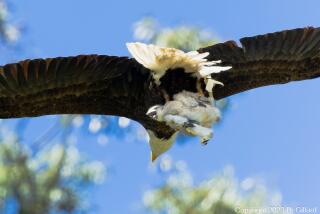CLIPBOARD : BREEDING BIRD: TURKEY VULTURE (Cathartes aura)
- Share via
Description: This rather large, eagle-like brownish-black bird has six-foot wingspan. Its featherless head and feet are red. From overhead, wings are black with dark gray outer band. They soar with wings in a shallow V. Length: 32 inches.
Habitat: Lowlands, mountains and cliffs. Often seen soaring in sky or perched on posts, carrion or in treetops. Roost sitings at Willian R. Mason Regional Park in Irvine.
Diet: Dead animals of any size. Young are fed regurgitant.
Displays: Courtship includes following-flight patterns with one partner diving at the other. Early-morning spread-wing postures provide means of absorbing solar energy and passively raising body temperature to daytime level.
Nest: Prefer cave or hollow stump with narrow entrance.
Eggs: White, occasionally with brown markings. Length: 2.8 inches.
Notes: Practices “kleptoparasitism,” where blue heron nestlings are harassed until they regurgitate their last meal, which is then scooped up and fed to turkey vulture chicks. Incorrectly called “buzzards.”
Breeding bird atlas: To report bird breeding activity in your neighborhood, or to get information on the breeding bird atlas, call Sea and Sage Audubon Society members Sylvia Gallagher, (714) 962-8990, or Nancy Kenyon, (714) 786-3160.
Note: Map is divided into 5-kilometer squares so that Audubon Society volunteers can more easily survey areas on a regular basis.
Sources: Sea and Sage Audubon Society; “The Birder’s Handbook,” Ehrlich, Dobkin and Wheye, Fireside Books (1988); “Field Guide to the Birds of North America,” National Geographic Society (1987); “Birds of Southern California: Status and Distribution,” Garrett and Dunn, Los Angeles Audubon Society (1981).
More to Read
Sign up for The Wild
We’ll help you find the best places to hike, bike and run, as well as the perfect silent spots for meditation and yoga.
You may occasionally receive promotional content from the Los Angeles Times.






